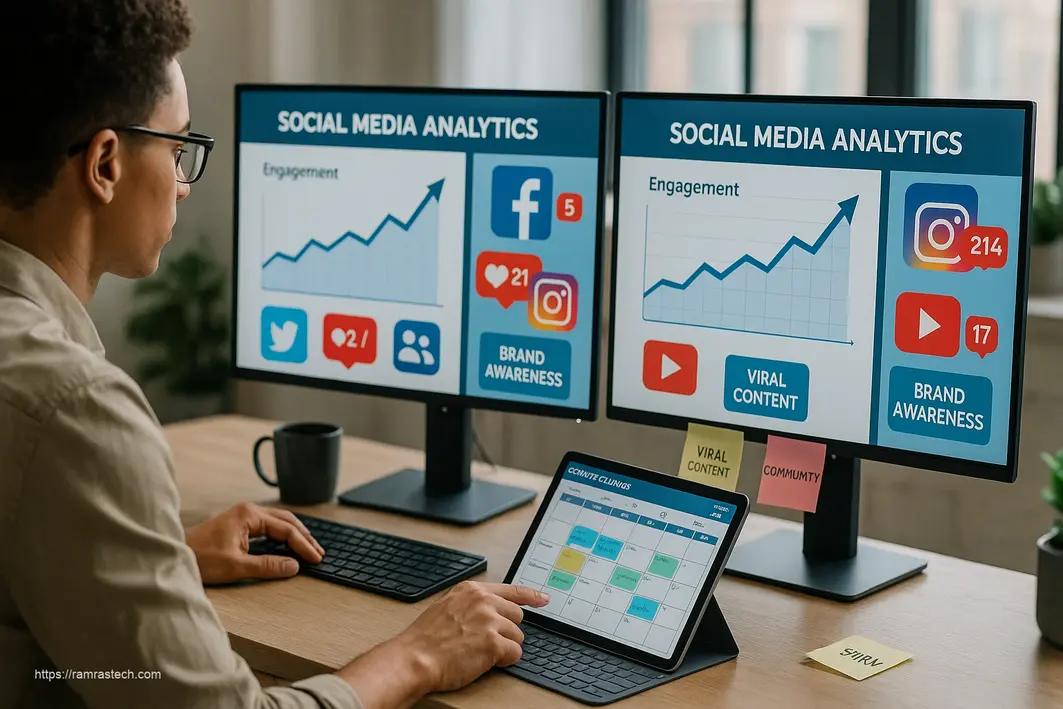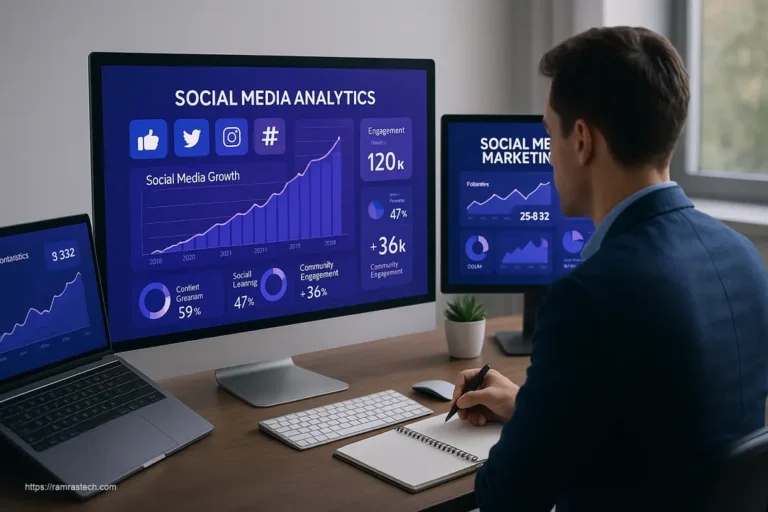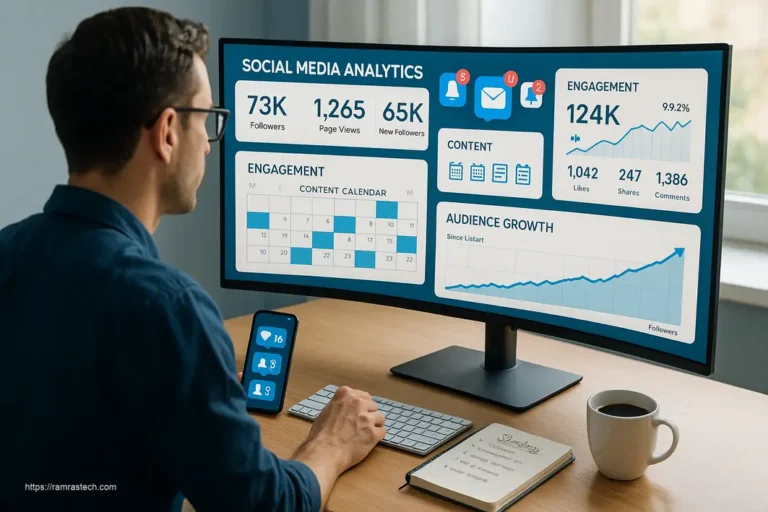5 Proven Social Media Marketing Hacks for Unparalleled Engagement

The digital landscape never stands still, especially when it comes to social media. Just when you think you’ve mastered Instagram, TikTok changes the game. And while your Facebook strategy is humming along, LinkedIn rolls out new features that you can’t ignore.
So how do successful brands stay ahead? They use social media marketing hacks – those clever, sometimes unconventional tactics that maximize results without draining resources. Today, I’m spilling the beans on the strategies that can transform your social presence from “meh” to “wow.”
What Exactly Are Social Media Marketing Hacks?
Let’s be real – social media marketing hacks aren’t about cutting corners. They’re strategic shortcuts that help you work smarter, not harder. These tactics let you bypass the usual trial-and-error process, leveraging proven techniques that accelerate growth and engagement.
Think of them as your secret weapons in a crowded digital battlefield where everyone’s fighting for the same eyeballs.
Why Traditional Social Media Approaches Fall Short
The painful truth? What worked in social media last year might be completely ineffective today. Algorithms change constantly, user preferences shift, and competition grows fiercer by the day.
Many brands are stuck in outdated routines:
- Posting the same content across all platforms
- Focusing solely on follower counts over engagement
- Creating content without strategic purpose
- Neglecting data and analytics
These approaches simply don’t cut it anymore. It’s time for some game-changing social media marketing hacks.
Hack #1: The Strategic Timing Advantage
Posting when your audience is most active seems obvious, right? Yet it’s amazing how many brands miss this opportunity.
Here’s the hack: Don’t just post during “peak hours” – get more specific. Each platform has its own unique prime times, and your specific audience might differ from the average.
Try this: Use platform analytics to identify your top 3 engagement windows. Then schedule your most important content for these precise times. For most brands, Tuesday through Thursday, 9-11 AM often outperforms evenings and weekends for B2B content, while evenings and Saturdays frequently work better for B2C engagement.
A client in the fitness industry saw a 37% jump in engagement after switching their Instagram posts from evenings to the 6-7 AM slot – when their audience was browsing while preparing for morning workouts.
Hack #2: The Content Repurposing Revolution
Creating fresh content constantly is exhausting. Smart marketers know the secret: repurposing is your best friend.
One blog post can become:
- 5-7 social media posts
- A slide deck for LinkedIn
- An infographic for Pinterest
- Bite-sized tips for Twitter/X
- Short video clips for Instagram/TikTok
Try this: Start with your highest-performing piece of content. Break it into multiple formats, adjusting the tone and format for each platform. This approach can generate weeks of content from a single asset.
For example, if you’ve written a comprehensive guide on email marketing, turn the main points into carousel posts for Instagram, create short how-to videos demonstrating key techniques for TikTok, and transform statistics into eye-catching graphics for Twitter.
Hack #3: The 80/20 Engagement Rule
Many brands make a critical mistake: they focus entirely on broadcasting rather than engaging. The most successful accounts follow what I call the 80/20 rule of social engagement.
Spend 20% of your time creating content and 80% engaging with others. This includes:
- Responding to every comment on your posts
- Engaging with followers’ content
- Participating in relevant conversations
- Joining community discussions
Try this: Block 30 minutes daily specifically for engagement activities. Use this time solely for meaningful interactions, not content creation or scheduling.
A small jewelry brand I worked with tripled their engagement rate in just three weeks by committing to responding to every comment within 2 hours and spending time each day engaging with complementary (non-competing) accounts.
Hack #4: Pattern Interruption Content
When everyone zigs, you should zag. Pattern interruption content stands out precisely because it breaks from what users expect to see in their feeds.
This might include:
- Unexpected formats (like hand-drawn images in a feed full of stock photos)
- Contrarian viewpoints on industry trends
- Behind-the-scenes content that shows vulnerability
- Unusually formatted posts (like single-word lines that create visual rhythm)
Try this: Review your last 10 posts. Now create something that looks and feels completely different from anything you’ve done before—while still staying true to your brand values.
A B2B software company broke their streak of polished corporate posts with a candid “failure story” about a product launch that flopped. It became their most commented post of the year, with prospects appreciating their transparency.
Hack #5: The Micro-Influencer Multiplier
Forget celebrity endorsements with their astronomical fees. The real ROI champions are micro-influencers with 5,000-30,000 highly engaged followers.
These creators typically have:
- Higher engagement rates (often 2-5x higher than macro-influencers)
- More authentic connections with their audience
- Greater trust and credibility
- Much lower collaboration costs
Try this: Identify 3-5 micro-influencers in your niche and develop relationships before pitching collaborations. Engage with their content genuinely for at least two weeks before reaching out.
A skincare brand partnered with 15 micro-influencers instead of one celebrity, spending the same budget but generating 4x more conversions and reaching more targeted audience segments.
Hack #6: Story Stacking for Maximum Visibility
Stories on Instagram, Facebook, and now LinkedIn provide unique opportunities for visibility. But random, sporadic stories don’t maximize the format’s potential.
Enter story stacking – the practice of posting multiple interconnected stories in a strategic sequence that keeps viewers engaged from first to last frame.
Try this: Create 5-7 story frames that follow a narrative arc – hook, problem, solution, evidence, call-to-action. Post them in rapid succession during high-traffic times.
The key is making the first frame irresistibly clickable and creating enough curiosity that viewers tap through the entire sequence. Retail brands have seen particular success with “tutorial” story stacks that show product transformations across multiple frames.
Hack #7: The Comment Conversion Technique
Comments are more than vanity metrics – they’re conversion opportunities hiding in plain sight.
When someone comments on your content, they’re demonstrating active interest. This is your chance to deepen the relationship and potentially move them further down your funnel.
Try this: Create a simple response framework for comments:
- Thank the commenter specifically by name
- Add value by providing additional information
- Ask a follow-up question that continues the conversation
- For particularly engaged commenters, consider a soft call-to-action (“If you’re interested in learning more, check out our guide on…”)
A financial advisor implemented this technique and tracked a 23% conversion rate from comment conversations to consultation bookings – far higher than any other social channel.
Hack #8: Leveraging User-Generated Content (UGC)
Your customers are creating content about your products and services every day. Harnessing this UGC is one of the most powerful social media marketing hacks available.
UGC has built-in benefits:
- It’s authentic and trusted more than brand-created content
- It saves you creation time and resources
- It makes featured customers feel valued and appreciated
- It shows prospective customers real-world applications
Try this: Create a branded hashtag and actively encourage customers to share their experiences. Then, establish a weekly feature where you showcase the best user content (with permission).
Make it even more effective by offering a small incentive – like a discount code or free shipping – for customers whose content you feature. This creates a sustainable cycle of fresh content creation.
Hack #9: The Analytics Deep Dive
Most marketers glance at surface metrics – likes, comments, shares – without diving deeper into the insights that truly matter.
The hack is focusing on conversion-related metrics that directly impact your bottom line:
- Click-through rates to your website
- Time spent on landing pages after social referrals
- Conversion rates from social traffic
- Customer acquisition cost by platform
Try this: Schedule a monthly “social ROI review” where you analyze not just engagement metrics but business outcomes from your social efforts. This helps identify which platforms and content types are actually driving revenue, not just vanity metrics.
One e-commerce client discovered that while their Twitter posts received the least engagement, they actually drove higher-value purchases than their more popular Instagram content – a finding that completely reshaped their strategy.
Hack #10: The Cross-Platform Content Bridge
Instead of treating each social platform as a separate entity, create strategic bridges that guide followers from one platform to another.
This works by leveraging each platform’s strengths while acknowledging its limitations:
- Use Instagram to showcase visual elements
- Direct viewers to YouTube for the full tutorial
- Point to LinkedIn for in-depth industry analysis
- Use Twitter for real-time updates and conversations
Try this: For your next campaign, design a multi-platform journey that starts with attention-grabbing visuals on Instagram, directs interested users to a more comprehensive YouTube video, and concludes with a conversion opportunity on your website.
A travel agency successfully implemented this approach by posting stunning destination photos on Instagram, linking to comprehensive travel guides on their blog, and offering exclusive booking discounts for those who followed the full journey.
Hack #11: Emotional Trigger Content
Content that evokes strong emotions gets shared more often – it’s simply human nature. The key is identifying which emotions resonate most with your specific audience.
While positive emotions generally outperform negative ones, the most powerful emotional triggers include:
- Awe and inspiration
- Amusement and joy
- Surprise and curiosity
- Validation and identity reinforcement
Try this: Analyze your top 10 performing posts of all time. What emotions did they evoke? Create a content calendar that intentionally incorporates these emotional triggers into future posts.
A nonprofit organization doubled their share rate by shifting from statistics-heavy posts to story-based content that showcased individual success stories, triggering emotions of hope and inspiration.
Hack #12: Strategic Hashtag Clustering
Hashtags remain powerful discovery tools, but the approach needs refinement. Instead of using maximum hashtags or trending-only tags, create strategic clusters of related hashtags that target specific audience segments.
Try this: Develop 3-5 hashtag clusters with 5-7 tags each that target different aspects of your audience:
- Industry-specific hashtags (for peers and B2B opportunities)
- Interest-based hashtags (for potential customers)
- Location-based hashtags (for local relevance)
- Community hashtags (for like-minded groups)
Rotate these clusters based on your content focus rather than using the same hashtags repeatedly. This approach helped a local bakery increase their discovery rate by 47% by matching hashtag clusters to specific product categories.
Hack #13: The Social Listening Advantage
While everyone focuses on broadcasting, smart brands gain edge through strategic listening. Social listening tools help you monitor conversations about:
- Your brand and products
- Your competitors
- Industry trends and pain points
- Customer feedback and suggestions
Try this: Set up listening alerts for your brand, key competitors, and industry terms. Then create a weekly review process to identify content opportunities from these conversations.
One tech company noticed customers frequently mentioning a specific feature challenge on Twitter – not tagging the company directly. By proactively addressing this issue in their content, they positioned themselves as responsive and customer-focused, earning significant goodwill.
Hack #14: Platform-Exclusive Content
The practice of posting identical content across all platforms is convenient but ineffective. Each social channel has its own culture, format preferences, and audience expectations.
The hack is creating platform-exclusive content that gives followers a reason to connect with you across multiple networks.
Try this: Assign a specific content type or theme to each platform:
- LinkedIn for industry insights and professional development
- Instagram for visual storytelling and product showcases
- Twitter for news, updates, and conversations
- TikTok for behind-the-scenes and personality-driven content
Announce these distinctions to your audience: “Follow us on LinkedIn for weekly industry reports you won’t find anywhere else” or “Our TikTok gives you exclusive behind-the-scenes content.”
Hack #15: The Conversation Starter Formula
Engagement often begins with effective questions, but not all questions are created equal. Generic questions like “What do you think?” rarely prompt meaningful responses.
Instead, use the conversation starter formula:
- Present a specific situation or scenario
- Offer your perspective or insight
- Ask a targeted, thought-provoking question that taps into experience or opinion
Try this: Instead of “Do you use email marketing?” try “We’ve noticed open rates dropping on Mondays but skyrocketing on Thursdays. We’re shifting our strategy accordingly. What day has brought your best engagement results and why?”
This approach signals you’re looking for a genuine discussion, not just comment accumulation. A marketing consultant increased their average comments per post from 8 to 37 by implementing this formula.
Putting These Social Media Marketing Hacks Into Practice
With 15 powerful hacks at your disposal, the question becomes: where should you start?
I recommend implementing these changes gradually rather than overhauling your entire approach at once. Choose 2-3 hacks that address your most pressing challenges, implement them consistently for 30 days, measure the results, and then expand your approach.
Remember that the most effective social media marketing isn’t about being everywhere or doing everything. It’s about being strategic, consistent, and attentive to what truly resonates with your audience.
FAQ: Social Media Marketing Hacks
How often should I post on social media for optimal engagement?
Consistency trumps frequency. Rather than posting multiple times daily, focus on maintaining a regular schedule your audience can rely on. Most brands see better results from 3-5 high-quality posts weekly than daily low-effort content. The ideal frequency also varies by platform: LinkedIn (1-2x weekly), Instagram (3-5x weekly), Twitter (daily), and TikTok (3-5x weekly) represent balanced approaches for most brands.
Which social media platforms should small businesses focus on?
Instead of spreading yourself thin across all platforms, choose 2-3 based on where your target audience is most active. For local businesses, Facebook and Instagram often deliver the best ROI. B2B companies typically find more success on LinkedIn and Twitter. The platforms where you can consistently create quality content that resonates with your specific audience will always outperform those where you maintain a minimal presence.
How can I increase engagement without spending on ads?
Focus on building genuine connections rather than broadcasting. Respond to every comment, participate in relevant communities, and create content that solicits opinions and experiences. User-generated content campaigns, behind-the-scenes glimpses of your business, and highlighting customer success stories all drive engagement without ad spend. Consistency in your posting schedule and authentic interactions will build momentum organically over time.
What’s the best way to measure social media ROI?
Look beyond vanity metrics like followers and likes to focus on outcomes that impact your business. Set up proper UTM parameters for all social links to track website traffic and conversions. Measure leads generated, email signups, and actual sales attributed to social sources. For brand awareness, track metrics like reach, share of voice compared to competitors, and sentiment analysis. The most meaningful metrics always tie back to your specific business objectives.
How do I keep up with constant algorithm changes?
Rather than chasing algorithms, focus on the fundamentals that remain consistent: creating valuable content that generates authentic engagement. Follow official platform blogs and 2-3 reputable social media news sources to stay informed without overwhelm. Most importantly, regularly review your own analytics to identify what’s working specifically for your audience—this personalized data will always be more valuable than generic best practices.
Remember: the most effective social media marketing hack is building genuine relationships with your audience through consistent value. All the technical tactics in the world can’t replace authentic connection.






